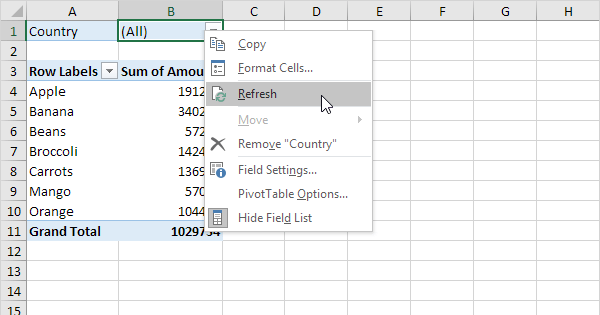
:max_bytes(150000):strip_icc()/CreatePivotTable-5be0ebcc46e0fb0026462908.jpg)
In order to do that, you need to drag and place Product field either in Row or Column Label area and place Amount field in Values area to sum their respective order amounts. Single Dimensional Pivot TableĪ single dimensional Pivot table summarizes dataset either in Row layout or Column layout for the selected data fields.įor example, if you want to see the summarized report of all products only, then it is called a single dimensional Pivot table. Number fields are placed in Values area to make a calculation, and other data fields are placed in Row, Column and Filter areas of Pivot Table Fields list panel as per requirement. You can create single dimensional or two-dimensional Pivot tables by placing data field in their respective Labels as per your requirement. You need to pick and drag data fields from Field List panel and place them in Row Labels, Column Labels, Filter and Values areas to generate their report view on the left-hand side. Press OK.Īfter inserting a Pivot Table, Excel generates the Report View pane on the left side and lists all the data fields in Pivot Table Field List panel on right side. Alternately, you can select Existing Worksheet and location where you want the Pivot table report to be placed. Excel automatically selects your data set and by default creates a New Worksheet where you want the Pivot table report to be placed.


Each data field should be formatted as text, number or date as per type of data it contains. Each data type should be laid out in a separate column having a header on top, called a data field.
Pivot tables in excel how to#
How to create a pivot table in Excel Before you create a Pivot table in Excel, it is important to format your data correctly, otherwise, it will not generate correct results. You don’t need to apply difficult formulas to analyze your data, as it is just some click away to summarize and create reports. You can explore your data and create a different look and feel about your data to make quick business decisions. A pivot table allows you to look at your data in a different way. This tool summarizes big data sets in a user-friendly, easy to understand and meaningful report. In this article, you will learn how to create a Pivot table in Excel. However, anyone using a recent standalone version of Excel (Excel 2021, 2019, or 2016) should be able to follow along with the course contents.How to Create a Pivot Table in Excel Pivot tables in Excel are a tool used to analyze big data sets. Note: This course was recorded in Microsoft 365. Plus, he goes over how to create PivotCharts to visualize your data, enhance PivotTables with macros, and use the Data Model feature to build PivotTables from related tables. Curt steps you through how to sort and filter PivotTable data, format your PivotTable and, and apply conditional formats. He demonstrates ways to summarize your data, add calculated fields, filter your results, and format your layout to make it more readable. Curt explains how to build PivotTables from single or multiple data sources, pivot and configure a PivotTable, define a default PivotTable layout, and more. In this course, Excel power user Curt Frye shows you how to navigate the complexity of PivotTables while taking advantage of their power. Many Excel users aren’t sure how to use PivotTables.


 0 kommentar(er)
0 kommentar(er)
